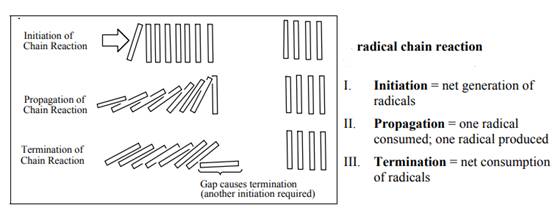
Concept explainers
Interpretation: Mechanism for monobromination of methane that includes initiation, propagation and termination steps should be written.The value of
Concept introduction: The monobromination performed with ultraviolet light proceeds via radical chain mechanism. Bromine transforms
It is summarized in the illustration below:

The formula to calculate
Want to see the full answer?
Check out a sample textbook solution
Chapter 3 Solutions
Organic Chemistry: Structure and Function
- Consider the compound 2,4-dimethyl-3-isopropylpentane. How many unique radical structures can be derived from this hydrocarbon when it undergoes free radical substitution? Write the number of free radicals formed.arrow_forwardCalculate the enthalpy of benzene from its enthalpy of combustion and the enthalpy of combustion of cyclohexanearrow_forwardThe heat of combustion of 2-methylheptane, C8H18, is 5464 kJ/mol. How much energy is released during the complete combustion of 399 grams of 2-methylheptane ? a) 19,100 kJ b) 21,800 kJ c) 16,200 kJ d) 20,100 kJarrow_forward
- Find the butanol combustion enthalpy using bond energy and calculate the value of the change in heat of combustion due to the addition of a CH2 unit in the given alcoholarrow_forwardWrite the equation for the oxidation of pentane (C5H12). What is the sum of the coefficients for the reactants and products?arrow_forwardWrite a balanced equation to show the reaction of gaseous ethane with gaseous oxygen to form carbon monoxide gas and water vapor. C2H6(g)+7 O(g) → 2 CO2(g)+3 H2O(g)C2H6(g)+7 O(g) → 2 CO2(g)+3 H2O(g) C2H6(g)+5 O(g) → 2 CO(g)+3 H2O(g)C2H6(g)+5 O(g) → 2 CO(g)+3 H2O(g) 2 C2H6(g)+7 O2(g) → 4 CO2(g)+6 H2O(g)2 C2H6(g)+7 O2(g) → 4 CO2(g)+6 H2O(g) 2 C2H6(g)+5 O2(g) → 4 CO(g)+6 H2O(g)2 C2H6(g)+5 O2(g) → 4 CO(g)+6 H2O(g) 2 CH3(g)+5 O(g) → 2 CO(g)+3 H2O(g)2 CH3(g)+5 O(g) → 2 CO(g)+3 H2O(g)arrow_forward
- Propane, C3H8, is a hydrocarbon that is commonly used as a fuel.(a) Write a balanced equation for the complete combustion of propane gas.(b) Calculate the volume of air at 25 °C and 1.00 atmosphere that is needed to completely combust 25.0 grams of propane. Assume that air is 21.0 percent O2 by volume. (Hint:use the information that 1.00 L of air at 25 °C and 1.00 atm contains 0.275 g of O2 per liter.)(c) The heat of combustion of propane is −2,219.2 kJ/mol. Calculate the heat of formation, ΔH°f of propane given that ΔH°f of H2O(l) = −285.8 kJ/mol and ΔH°f of CO2(g) = −393.5 kJ/mol. (d) Assuming that all of the heat released in burning 25.0 grams of propane is transferred to 4.00 kilograms of water, calculate the increase in temperature of the water.arrow_forwardThe average bond enthalpy for C-His 413 kJ/mol. 413 kJ of energy is required to break a mole of CH into atoms: CH(g)→C(g) + H(g), AH=413 kJ Using this information, and your answer from Part A, calculate the enthalpy change of the reaction from Part B. That is, calculate the energy required to break only the carbon-carbon bonds in benzene. Express your answer to four significant figures and include the appropriate units. > View Available Hint(s) HA AHrxn = Value Units Submit Part D Complete previous part(s) Next > Provide Feedback 9:33 PM B. W Word Google .. Spotify .. 61°F 11/17/2021arrow_forwardFree radical fluorination of methane is uncontrollably violent and free radical iodination of methane is a very poor reaction. Explain these observations in light of bond energies.arrow_forward
- With the catalyst AlCl3 present, which reactant is needed to convert benzene to ethylbenzene?arrow_forwardWhat is the enthalpy change to convert one mole of methane to methanol?arrow_forwardA student added bromine solution to a hydrocarbon sample that contained an isomer of C6H12 (E) in the absence of light. After shaking the sample, the student noticed that the colour of the bromine solution changed from orange to colourless. Use the following information to answer the question 6. An interpretation that could be made from the student's observations is that the hydrocarbon sample isi and the IUPAC name of the sample could be ii . The statement above is completed by the information in row: i saturated saturated unsaturated unsaturated Row A B C D wer (2 marks) ii hex-2-ene cyclopentane hex-2-ene cyclopentane 0arrow_forward
 Chemistry: The Molecular ScienceChemistryISBN:9781285199047Author:John W. Moore, Conrad L. StanitskiPublisher:Cengage Learning
Chemistry: The Molecular ScienceChemistryISBN:9781285199047Author:John W. Moore, Conrad L. StanitskiPublisher:Cengage Learning Chemistry & Chemical ReactivityChemistryISBN:9781337399074Author:John C. Kotz, Paul M. Treichel, John Townsend, David TreichelPublisher:Cengage Learning
Chemistry & Chemical ReactivityChemistryISBN:9781337399074Author:John C. Kotz, Paul M. Treichel, John Townsend, David TreichelPublisher:Cengage Learning Chemistry & Chemical ReactivityChemistryISBN:9781133949640Author:John C. Kotz, Paul M. Treichel, John Townsend, David TreichelPublisher:Cengage Learning
Chemistry & Chemical ReactivityChemistryISBN:9781133949640Author:John C. Kotz, Paul M. Treichel, John Townsend, David TreichelPublisher:Cengage Learning ChemistryChemistryISBN:9781305957404Author:Steven S. Zumdahl, Susan A. Zumdahl, Donald J. DeCostePublisher:Cengage Learning
ChemistryChemistryISBN:9781305957404Author:Steven S. Zumdahl, Susan A. Zumdahl, Donald J. DeCostePublisher:Cengage Learning Chemistry: An Atoms First ApproachChemistryISBN:9781305079243Author:Steven S. Zumdahl, Susan A. ZumdahlPublisher:Cengage Learning
Chemistry: An Atoms First ApproachChemistryISBN:9781305079243Author:Steven S. Zumdahl, Susan A. ZumdahlPublisher:Cengage Learning





